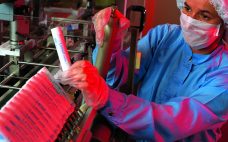Barth syndrome is a serious X-linked genetic disorder that primarily affects boys. It is caused by a mutation in the tafazzin gene (Taz) that creates an inborn error of lipid metabolism. The condition is named after Dutch pediatric neurologist Peter Barth, who published his discovery of it in 1983. The syndrome often manifests at birth in a number of ways. Patients are born hypotonic, show signs of cardiomyopathy within the first few months of life, and despite adequate nutrition experience…
Search Results for: niche disease
October Spotlight
Introducing New Editorial Advisor Dr. Sanjay Nilapwar works as a purification process scientist in the novel-molecules group of Medimmune in Gaithersburg, MD, where he is also part of the platform chemistry, manufacturing, and controls (CMC) development team for antibody–drug conjugate products. In this position, he looks after the transitioning of ADC and monoclonal antibody (MAb) molecules as candidate drugs from development to the manufacturing stage, which encompasses cycles 1 and 2 purification process development, technology transfer and related CMC aspects…
May Spotlight
Welcome New Editorial Advisor David Rabuka is global head of research and development in chemical biology at Catalent Biologics, with overall responsibility of overseeing continued research and development of SMARTag technology. He also oversees strategy, resource allocation, and scientific oversight of preclinical and clinical studies. David joined Catalent Biologics following Catalent’s acquisition of Redwood Bioscience Inc., where he was founder, president, and chief scientific officer. David’s scientific areas of expertise include chemical synthesis; drug delivery; translational research; chemistry, manufacturing, and…
From the Editor
This issue introduces an adjustment to our themes of coverage, which for much of BPI’s history have rotated from production to processing to manufacturing, with the introduction a few years ago of the “bioexecutive” focus in December. My somewhat pedantic nature always was slightly offended by the idea of separating “manufacturing” from two other themes that were also elements of manufacturing themselves, even though it was mostly just a matter of semantics. And our new product-development theme encompasses much of…
Spotlight for February 2017
Introducing New Editorial Advisor Jason Condon is a senior CMC project manager at Vaccinex, Inc., in Rochester, NY as well as an assistant adjunct professor in biomedical engineering at the University of Rochester. He has held roles in biopharmaceutical manufacturing and process development at Bristol Myers Squibb and Janssen R&D. His expertise in cell culture and current good manufacturing practice (CGMP) manufacturing has contributed to developing manufacturing processes for monoclonal antibody (MAb), cell therapy, and vaccine production throughout his 13-year…
Spotlight
Niche Disease: Autoimmune/Noninfectious Uveitis Uveitis is the inflammation of the uvea, the pigmented layer that lies between the eye’s inner retina and its outer fibrous layer composed of the sclera and cornea. The most frequent etiologies are autoimmune diseases such as Behçet disease. Noninfectious intermediate and posterior uveitis (NIU) represents 10–15% of uveitis cases, making it the fourth leading cause of blindness in the developed world. About one in 4,500 patients suffer with this condition. Uveitis typically has been treated…
Spotlight
Niche Disease: Soft-Tissue Sarcoma (STS) by Cheryl Scott Cancer comes in two forms: the more common carcinoma form (of epithelial origin) and the less common sarcoma form. Sarcoma cells are mesenchymal in origin. Soft-tissue sarcomas are cancers of tissues such as fat, muscle, nerves, tendons, the lining of joints, blood vessels, or lymph vessels. Because there are at least 50 different types of STS, it is more accurately described as a family of related diseases rather than a single disease.…
Spotlight
Niche Disease: CAPS by Cheryl Scott Cryopyrin-associated periodic syndromes (CAPS) are rare, inherited, autoinflammatory diseases with similar genetics and overlapping symptoms. The group includes three subtypes: familial cold autoinflammatory syndrome (FCAS); Muckle-Wells syndrome (MWS); and neonatal-onset multisystem inflammatory disease (NOMID), also called chronic infantile neurologic cutaneous articular (CINCA) syndrome. The cryopyrin protein is critical to production of the inflammatory cytokine interleukin-1β (IL-1β), which triggers inflammatory response when it binds to inflammatory cells. Genetic alterations in cryopyrin cause IL-1β overproduction, resulting…
Spotlight
Niche Disease: Epidermolysis Bullosa by Cheryl Scott Epidermolysis bullosa (EB) is a group of rare diseases that cause skin to blister easily. In severe cases, blisters may even be internal (e.g., in mucosal tissues or organs). More than 300 mutations have been identified in this condition. Most of the many types of EB are inherited, and the condition usually manifests in infants and young children; some patients don’t develop symptoms until adolescence or early adulthood. Exceptionally mild cases may remain…
Spotlight
Niche Disease: Legionnaires’ Disease by Cheryl Scott Gram-negative, aerobic Legionella pneumophila bacteria were first identified as the cause of an outbreak of severe pneumonia at an American Legion Convention in a Philadelphia convention center in 1976. Since then (and probably long before), it has been responsible for occasional such outbreaks around the world. For example, an epidemic of the disease probably occurred in Minnesota in 1957. Such incidents are usually associated with poorly maintained artificial water systems (e.g., cooling towers…





